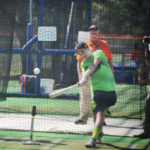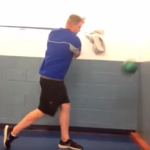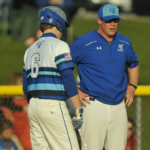Taking a Good Approach at the Plate
As coaches, we have all see hitters who overachieve and underachieve their mechanics and physical abilities at the plate. We cannot, for the life of us, figure out why the kid who absolutely crushes the ball in the cage, has solid mechanics, and a quick bat hits 50 points lower than the kid who looks far less impressive in the cage, has slower hands, and questionable mechanics. If this is the case, look no further than pitch selection and plate approach.
We often hear coaches reminding players to have a proper approach at the plate, but what exactly does that mean? A good approach at the plate means different things depending on the age level you are coaching.
Basic Levels
At the most basic levels, a proper approach simply means getting a good pitch to hit in any count and not swinging at pitches far out of the strike zone. Pitchers may not be changing speeds very much, and certainly are not locating pitches very well below the age of 12. At this age level simply emphasize getting a good pitch to hit and protecting the the strike zone with two strikes.
Advanced Levels
Once pitchers begin to chance speeds and locate pitches, the concept of taking a quality at bat changes quite a bit. The goal at this level is still to get a good pitch to hit, but the concept of a “good pitch” needs to be refined. The toughest idea to get across to your players is that not every fastball that is a strike is also a good pitch to hit. For example, a 0-0 fastball on the outside corner is not a good pitch to hit. If the hitter swings at it, they will most likely get themselves out. If they take it, the they are now down 0-1. You would much rather have your hitter down 0-1 than sitting in the dugout. Similarly, unless they are a very good breaking ball hitter (which few kids under 18 are), they should lay off most curveballs with fewer than two strikes.
[wp_ad_camp_3]
This might also take some getting used to as a coach. It is difficult to watch fastball hitters let fastball strikes go by early in the count. Realize that just because the it looked like a good pitch to hit from the third base coach’s box, doesn’t make it so. Maybe the pitch was on the outside corner, or perhaps the velocity or release point wasn’t exactly what the hitter was expecting. Resist the urge to jump all over them because they let a fastball go by. Instead, discuss the pitch or at bat, and let them tell you if it was a good pitch to hit or not. Perhaps you are the one who didn't see the pitch correctly.
No strike approach
With no strikes, have your hitters concentrate on getting a “double pitch” to hit. A double pitch is simply a fastball in their favorite zone to hit. They should be able to take an aggressive swing at this pitch and hit a double.
As a coach, realize that hitting a baseball is the most difficult thing in sports, so just because they get a good pitch to hit doesn’t mean they will hit a double. As long as they swing at the right pitch and put a good swing on it, they have won that pitch, regardless of the outcome. The “double pitch” zone tends to be very small and will vary by hitter. Generally, it is thigh to waist high and is a few inches wide over the middle of the plate.
One strike approach
With one strike, hitters should be looking for a “barrel pitch.” A barrel pitch is a fastball that they can get the barrel of the bat on and hit a line drive. Generally this will be a pitch thigh to waist high that is not on the outside or inside corner. This zone is slightly larger than the zero strike zone, but still gives the pitcher the outside corner and knees. Again, the hitter would want to lay off of most breaking balls in this count.
[wp_ad_camp_3]
Two strike approach
It is very difficult to cover all 17 inches of home plate when a pitcher is throwing with good velocity and has the ability to change speeds and locate. In this situation, hitters should use the general tendency of most pitchers to their advantage. With two strikes, most pitchers will throw fastballs away and off-speed pitches. Because of this, hitters should be protecting the middle of the plate to 4 inches off the corner (umpires are humans too!). In either instance, hitters have to wait longer to swing (see “Opposite Field Hitting” post https://www.cornerstonecoachingacademy.com/opposite-field-hitting-theory-cues-and-drills/). The goal with two strikes should simply be to put the ball in play. If they strike out, especially looking, they haven’t given themselves a chance to get on base. If the ball is put in play there are a number of different ways they can reach base safely.
Higher levels
At the higher levels (above high school), the approach can be slightly complicated by the fact that many pitchers can throw any pitch for a strike in any count. While the overall approach should stay in tact, the hitter may have to slightly expand their one strike barrel zone, and may have to swing at breaking balls earlier in the count. Hitters may pick up on certain tendencies of the pitcher that might allow them to guess a certain pitch is coming. Common examples of this are a pitcher throwing a “get me over” breaking ball early in the count, or always following a strike with an off speed pitch. How much of this a hitter does will depend on their ability to recognize those tendencies, how strong the tendencies are, and how confident they are hitting breaking balls.
Practice good approaches
Just like any other skill, taking good at bats is a skill that needs to be practiced. Put your hitters in situations and counts during batting practice to allow them to work on their approach. It is unreasonable to ask hitters to do perform something in a game they have not practiced. Instead of simply having your hitters swing mindlessly during batting practice, make them work on pitch selection.
Summary
Next time your most talented hitter comes to you wondering why he is hitting .250 instead of .350, don’t fill his head with mechanical quick fixes, have a discussion with him about pitch selection and pay close attention to what pitches he is swinging in what count. During a season when there are limited practices, fixing an approach is much easier than fixing a mechanical flaw, and it may be the biggest reason for their struggles to begin with.
Resources:
8 Opposite Field Drills
1 Awesome Opposite Field Tactical GAme
Check Out Cornerstone Elite w/ Over 60 Tactical Games and Full Generating Offense Course
 Posted by Kyle Nelson
Posted by Kyle Nelson- Posted in Coaching Philosophy, Hitting, Mental Game
 Jun, 03, 2013
Jun, 03, 2013 3 Comments.
3 Comments.
Elite members login here
Check out what’s New/Hot!
Recognizing, Diagnosing, and Fixing Common Hitting Flaws eCourse The 3 metrics we tested on Blast motion sensors this year Sneak Peek Inside an Elite Q and A The batting practice continuum Elite Member’s area table of contents 50+ “Chaos” hitting drills
5 sample Chaos hitting drills FREE
Mental Skills and Culture Building The hitting pyramid Welcome Elite Member, Trey! Ideas for a pitcher first practice 12 week bat speed improvement plan Make plans this offseason to have your team playing their best baseball at the end of the year” Top 5 hitting drills to translate practice skill to game performanceHow we used Blast Motion sensors with a team in 2019
What to do if your hitters are overmatched Welcome Elite Member, Tommy! Setting your baserunners up for success Welcome Elite Member, Mike! A consulting call with Elite Member Matt FREE Web Clinic: Developing Athletic, Consistent, Extraordinary Infielders
 Coach Kyle Nelson
Coach Kyle Nelson






My theory starts with “hit the best pitch you will see during your at bat”. How many guys take a FB down the middle because it is 0-0 and then find themselves battling off speed pitches in a negative count situation? You must be able to drive the best pitch you see in your at bat, and you must recognize that the change-up down the middle may be that pitch instead of the FB down and out on 1-2.
@Mike – A quick bat and perfect mechanics will do nothing for a hitter if they swing at the wrong pitches.
@ David- I like that terminology. In most at bats (I coach at the high school level) you are going to get at least one good pitch to hit. You’d better be ready for it!
Great post. So true that the one and only “fix” (as if they are broken which is an entirely different subject) is changing “mechanics”. It’s too bad. Lots of wasted time and frustrated kids are the result.